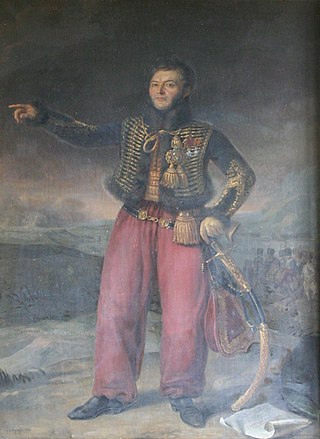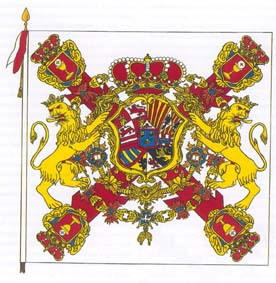
The Battle of Ocaña was fought on 19 November 1809 between French forces under Marshal Jean-de-Dieu Soult against the Spanish army under General Juan Carlos de Aréizaga, which suffered its greatest single defeat in the Peninsular War.

The Battle of Talavera was fought just outside the town of Talavera de la Reina, Spain some 120 kilometres (75 mi) southwest of Madrid, during the Peninsular War. At Talavera, a British army under Sir Arthur Wellesley combined with a Spanish army under General Cuesta fought in operations against French-occupied Madrid. At nightfall, the French army withdrew a short distance after several of its attacks had been repulsed; the allies, having suffered comparable casualties to the French, made no attempt to pursue.

A carabinier is in principle a soldier armed with a carbine, musket, or rifle, which became commonplace by the beginning of the Napoleonic Wars in Europe. The word is derived from the identical French word carabinier.

Antoine-Charles-Louis, Comte de Lasalle was a French cavalry general during the French Revolutionary and Napoleonic Wars. Often called "The Hussar General," he first gained fame for his role in the Capitulation of Stettin. Throughout his short career, he became known as a daring adventurer and was credited with many exploits, fighting on every front. He was killed at the Battle of Wagram.

Jacques Gervais, baron Subervie was a French general and politician.

The Battle of Medina de Rioseco, also known as the Battle of Moclín, was fought during the Peninsular War on 14 July 1808 when a combined body of Spanish militia and regulars moved to rupture the French line of communications to Madrid. General Joaquín Blake's Army of Galicia, under joint command with General Gregorio de la Cuesta, was routed by Marshal Bessières after a badly coordinated but stubborn fight against the French corps north of Valladolid.
In the Peninsular War, the Battle of Medellín was fought on 28 March 1809 and resulted in a victory of the French under Marshal Victor against the Spanish under General Don Gregorio Garcia de la Cuesta. The battle marked the first major effort by the French to occupy Southern Spain, a feat mostly completed with the victory at the Battle of Ocana later in the year.

The Battle of Cabezón was an engagement early in the Peninsular War on 12 June 1808 between Spain's Army of Castile, under Cuesta, based at Valladolid, and detachments of Marshal Bessières' French Army Corps under generals General Lasalle and Merle. Lasalle occupied Valladolid without opposition that same evening.

In the Battle of Alba de Tormes on 28 November 1809, an Imperial French corps commanded by François Étienne de Kellermann attacked a Spanish army led by Diego de Cañas y Portocarrero, Duke del Parque. Finding the Spanish army in the midst of crossing the Tormes River, Kellermann did not wait for his infantry under Jean Gabriel Marchand to arrive, but led the French cavalry in a series of charges that routed the Spanish units on the near bank with heavy losses. Del Parque's army was forced to take refuge in the mountains that winter. Alba de Tormes is 21 kilometres (13 mi) southeast of Salamanca, Spain. The action occurred during the Peninsular War, part of the Napoleonic Wars.

Étienne-Marie-Antoine Champion, comte de Nansouty was a French cavalry commander during the French Revolutionary Wars who rose to the rank of General of Division in 1803 and subsequently held important military commands during the Napoleonic Wars.

The Mounted Grenadiers of the Imperial Guard was a heavy cavalry regiment in the Consular, then Imperial Guard during the French Consulate and First French Empire respectively. They were the senior Old Guard cavalry regiment of the Imperial Guard and from 1806 were brigaded together with the Dragoons of the Imperial Guard.
The II Cavalry Corps of the Grande Armée was a French military unit that existed during the Napoleonic Wars. It was first formed in December 1806, but only enjoyed a brief existence under Marshal Jean-Baptiste Bessières. The II Cavalry Corps was reconstituted for the invasion of Russia in 1812 and commanded by General Louis-Pierre Montbrun who was killed in battle, as was his successor a few hours later. During the War of the Sixth Coalition, General Horace François Bastien Sébastiani de La Porta led the II Cavalry Corps in 1813, while General Antoine-Louis Decrest de Saint-Germain led the corps in 1814. During the Hundred Days, Emperor Napoleon Bonaparte raised the corps again and entrusted it to General Rémi Joseph Isidore Exelmans.

General José Miguel de la Cueva y de la Cerda, 14th Duke of Alburquerque (1775–1811) was an aristocrat, diplomat, and senior Spanish officer in the Peninsular War.

The Battle of Arzobispo on 8 August 1809 saw two Imperial French corps commanded by Marshal Jean-de-Dieu Soult launch an assault crossing of the Tagus River against a Spanish force under José María de la Cueva, 14th Duke of Alburquerque. Alburquerque's troops rapidly retreated after suffering disproportionate losses, including 30 artillery pieces. El Puente del Arzobispo is located 36 kilometres (22 mi) southwest of Talavera de la Reina, Spain. The action occurred during the Peninsular War, part of a larger conflict known as the Napoleonic Wars.
The V Cavalry Corps of the Grande Armée was a French military unit that existed during the Napoleonic Wars. The corps was created in 1813 and fought until 1814. Emperor Napoleon Bonaparte first organized the corps during the summer armistice in 1813 and it fought at Dresden and Leipzig. General Samuel-François Lhéritier led the corps at first but was replaced by General Pierre Claude Pajol. After Pajol was wounded at Leipzig, General Édouard Jean Baptiste Milhaud commanded the corps at Hanau in 1813 and at Brienne, La Rothière, Mormant, Fère-Champenoise, and Paris in 1814.
The Reserve Cavalry Corps or Cavalry Reserve of the Grande Armée was a French military unit that existed during the Napoleonic Wars. In 1805, Emperor Napoleon Bonaparte appointed Marshal Joachim Murat to command all the cavalry divisions that were not directly attached to the army corps. During the Ulm campaign, Murat led his horsemen in successfully hunting down many Austrian units that escaped the capitulation of Ulm, before fighting at Austerlitz in December 1805. Under Murat, the Cavalry Reserve played a prominent role in the destruction of the Prussian armies after the Battle of Jena-Auerstedt in 1806. In 1812, the Reserve Cavalry Corps was split up into the I, II, III, and IV Cavalry Corps for the French invasion of Russia.

The Battle of Messkirch on 5 May 1800 was the major engagement in the War of the Second Coalition. It followed the Battle of Stockach on 3 May. The campaign began on 25 April when a French force emerged from the Kehl bridgehead. This marked the start of the offensive of Jean Victor Marie Moreau's Army of the Rhine against Paul Kray's army of Habsburg Austria and its Bavarian, Württemberg and other German allies.

The Cavalry Regiment El Rey is the oldest cavalry regiment in the Spanish Army, distinguishing itself on several occasions during the Peninsular War. They are best known for their charge at the Battle of Talavera where they dealt the decisive blow against General Jean François Leval's German Division.

Charles Claude Jacquinot commanded a French cavalry division at the Battle of Waterloo in 1815. He joined a volunteer battalion in 1791 and transferred to a light cavalry regiment as a junior officer in 1793. He earned promotion to squadron commander and was acting commander of his regiment at Hohenlinden in 1800. After serving in a staff position at Austerlitz in 1805, he led a light cavalry regiment at Jena in 1806. Promoted to general of brigade he led his horsemen at Abensberg, Raab and Wagram in 1809. During the French invasion of Russia he fought at Ostrovno, Smolensk and Borodino in 1812. During the 1813 German Campaign he led a cavalry brigade at Dennewitz and Leipzig. After being appointed general of division he fought at Second Bar-sur-Aube and Saint-Dizier in 1814. During the Hundred Days he rallied to Napoleon and led a light cavalry division in the Waterloo campaign. After 15 years of inactivity, he was restored to favor in the 1830s. Thereafter he held a number of commands and was appointed to the Chamber of Peers. His surname is one of the names inscribed under the Arc de Triomphe, on Column 20.
The combat of Mesas de Ibor was a French victory during the Peninsular War at which the Spanish troops under General Duke del Parque were defeated by Leval's division, made up of German battalions.
















